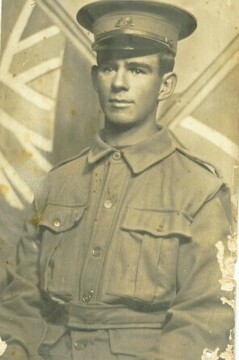
BOTTOMLEY, Harry
| Service Number: | 1885 |
|---|---|
| Enlisted: | 12 April 1915 |
| Last Rank: | Private |
| Last Unit: | 6th Infantry Battalion |
| Born: | Essendon, Victoria, Australia, 1896 |
| Home Town: | South Melbourne, Port Phillip, Victoria |
| Schooling: | Albert Park State School, Victoria, Australia |
| Occupation: | Railway employee |
| Died: | Killed in action, France, 12 December 1916 |
| Cemetery: |
London Cemetery and Extension, Longueval Plot X, Row J, Grave 18. (Remains discovered in 1954) |
| Memorials: | Australian War Memorial Roll of Honour |
World War 1 Service
| 12 Apr 1915: | Enlisted AIF WW1, Private, 1885, 6th Infantry Battalion | |
|---|---|---|
| 13 Apr 1915: | Involvement Private, 1885, 6th Infantry Battalion, --- :embarkation_roll: roll_number: '8' embarkation_place: Melbourne embarkation_ship: HMAT Wiltshire embarkation_ship_number: A18 public_note: '' | |
| 13 Apr 1915: | Embarked Private, 1885, 6th Infantry Battalion, HMAT Wiltshire, Melbourne |
Help us honour Harry Bottomley's service by contributing information, stories, and images so that they can be preserved for future generations.
Add my storyBiography contributed by Stephen Brooks
Harry Bottomley was one of three brothers who all served in the 6th Battalion AIF. Two were killed in action and the third was returned to Australia from Gallipoli with a severe gunshot wound to the leg. They were the sons of James Rutherford and Louisa Bottomley of St. Kilda, Victoria.
Harry had been captain of the Albert Park State School cricket team and a prominent footballer and was working as a railway porter.
Harry must have nearly set the AIF record for quick embarkation as he enlisted 12 April 1915, the day before he embarked. It was probably because his brother, Clifford, left with the 4th reinforcements 6th Battalion the same day.
A third brother, 902 Pte. Oswald George Bottomley, had enlisted in the original 6th Battalion AIF, during 1914, and was preparing for the Anzac landing when his two brothers were leaving Melbourne.
Oswald (Ossie) George Bottomley was killed in action at Krithia, Gallipoli on 8 May 1915, aged 29, when his two brothers were still at sea on their way to Egypt.
Harry and Clifford arrived on Gallipoli on 26 May 1915. Clifford only lasted four days before he was shot in the leg. He was evacuated immediately to Egypt and returned to Australia in July 1915.
Harry had gone from being a railway porter in Melbourne to fighting at Gallipoli in the space of seven weeks. He was the only one of his three brothers at the front on 31 May 1915. He was evacuated sick during late August 1915 until he rejoined the 6th Battalion at the end of October. He was transferred to the 58th Battalion during the reorganization of the AIF in Egypt during February 1916. Harry was also crimed on three occasions, once for absent without leave, once for attending a gambling school and once for sitting down on sentry duty when they arrived on the Western Front.
He survived the Battle of Fromelles, in which the 58th Battalion suffered extremely heavy casualties. He was reported killed in action on 12 December 1916, the only man of the battalion killed on that day, when the 6th Battalion was in a quieter part of the line near Bernafay Wood.
His remains were lost at the time and his name was placed on the Villers Bretonneux Memorial. Remarkably, his body was discovered in 1954, 38 years after his death, and buried in the London Cemetery at Longueval, Somme, France. The authorities were looking for his parents in 1955, but both his parents had been deceased for over 20 years by that time.
His surviving brother, Clifford, placed memorial notices for his two brothers in the papers, for many years after the war and in 1967, Clifford wrote to the Army making application for Harry’s Gallipoli medal, as next of kin.










